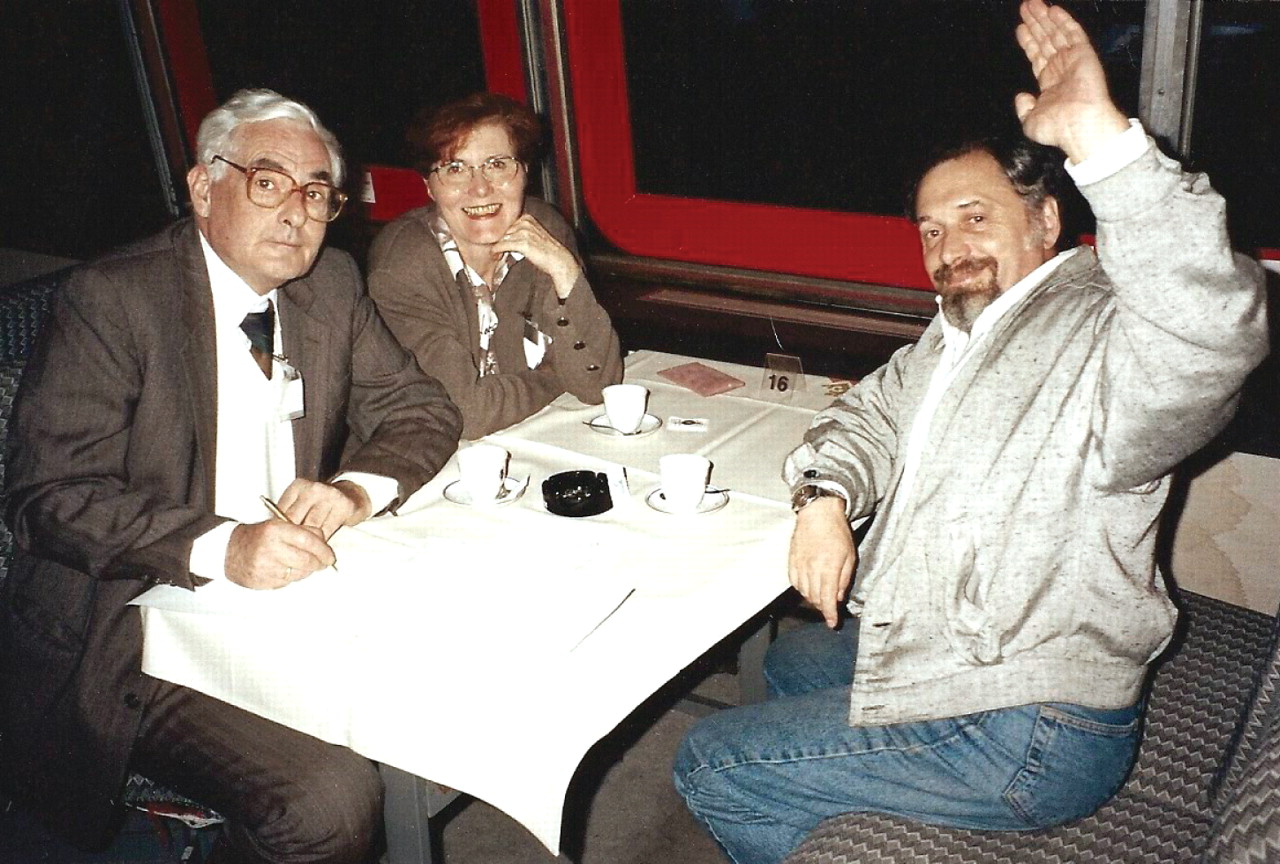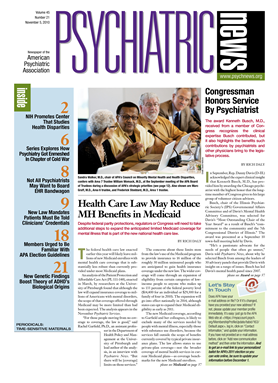In 1964, Pytor Grigorenko, a high-ranking Soviet military general and hero of World War II, was committed to psychiatric hospitalization by Soviet psychiatrists in the wake of Grigorenko's vigorous criticism of human-rights abuses in the Soviet Union.
In time, news of the general's confinement came to the attention of a Ukrainian psychiatrist named Semyon Gluzman, M.D., a connection that would prove critical, according to Robert van Voren, a Dutch human-rights activist and author of a book published this year, Cold War in Psychiatry: Human Factors, Secret Actors.
“Gluzman was a young Kiev psychiatrist who had contacts with dissident circles in his hometown,” van Voren told Psychiatric News. “Gluzman read [Grigorenko's] file and came to the conclusion that the man was not suffering from any mental disorder and that his incarceration had been for political reasons. Gluzman's report found its way to the KGB, and he was arrested and sentenced to 10 years in camp and exile.”
Fast forward to 1977 when APA recognized Gluzman's courage by making him a distinguished fellow of the Association. The same year saw the publication of Psychiatric Terror, a book by Peter Reddaway, a British political scientist specializing in the U.S.S.R., and British psychiatrist Sidney Bloch, M.D., documenting Soviet abuses of psychiatry to detain and control political dissidents.
Reddaway and Bloch received APA's Guttmacher Award for their work in 1978.
The events would prove to be a watershed in Cold War politics, one that would eventually draw Western psychiatry into a confrontation with the Soviets. The story of that confrontation constitutes a small epic involving high diplomacy and a cast of international characters pitting science and medical ethics against what many regard as a uniquely lurid feature of modern totalitarianism: the use of psychiatric diagnoses, in some cases augmented by the use of drugs, to stigmatize and contain political dissent.
The 1977 meeting of the World Psychiatric Association (WPA) in Honolulu resulted in a statement describing the rights of psychiatric patients and denouncing political abuses of the profession. Six years later the Soviets withdrew from the WPA, under threat of expulsion, and in 1989 the confrontation culminated in a remarkable visit by American psychiatrists led by the U.S. State Department and the National Institute of Mental Health in which the American delegation personally interviewed individuals believed to be incarcerated in psychiatric hospitals for their political activity.
It was a confrontation that would raise the international profile of American psychiatry and APA. It would also prove formative in the development of ethics regarding the interface of psychiatry and the law in America (see
Rift Changed U.S. Psychiatry). And it would serve as a subplot in the eventual unraveling and dissolution of the Soviet Union.
Central to APA's involvement was the figure of Melvin Sabshin, M.D., who served as medical director from 1974 to 1997. He was a staunch advocate for an international presence for APA (see
Sabshin's Past Led Him to Historic Crossroads) and during his tenure established the Office of International Affairs under the leadership of Ellen Mercer.
Past APA President and Trustee Lawrence Hartmann, M.D., a longtime advocate for human rights in psychiatry, remembers Sabshin's leadership as “quiet, diplomatic, but persistent” in the confrontation with Soviet abuses.
And van Voren recalled Sabshin as an invaluable ally in his role on the executive committee of the WPA. “He was a specialist in conflict resolution and was able to build bridges,” he told Psychiatric News. “I think his role in promoting human rights in mental health, strengthening the forces for an ethical psychiatry, and combating abuses by developing a generally accepted psychiatric nosology cannot be underestimated.”
Operating Under a Repressive Regime
That there were abuses of political dissidents involving psychiatry in the Soviet Union is widely acknowledged, and an accurate accounting of the number incarcerated in psychiatric hospitals for being on the wrong side of authority is unknown.
A central charge against the Soviets was the use of the diagnosis “sluggish schizophrenia”—a suspiciously elastic condition not recognized in Western psychiatry that appeared to encompass a great variety of behaviors. The 1989 visiting American delegation found no diagnosable mental illness among several incarcerated individuals they interviewed, while others suspected of being held for political reasons were released with no explanation prior to the delegation's arrival.
Moreover, charges of the use of sulfazine injections, ostensibly to enhance neuroleptic treatment but typically producing pain, immobility, and muscle necrosis (suggesting punitive rather than therapeutic purposes), were confirmed by the American delegation.
In the face of such tactics, it would be easy to regard the confrontation with Soviet psychiatry years later as one pitting the forces of light against pitch black. But those with knowledge of the period acknowledge many shades of gray: there were psychiatrists within the U.S.S.R. who worked, overtly or covertly, to help dissidents, as well as others who collaborated with KGB authorities out of a variety of motives.
Alan Stone, M.D., a past APA president and longtime human-rights activist, protests the wholesale vilification of an entire profession that was poorly trained by Western standards, pervasively stigmatized, and operating under the constraints of the Soviet KGB, which had the power to reach into virtually every aspect of life and society.
Stone, who visited the Soviet Union and spoke to psychiatrists there, does not deny that there were psychiatrists doing the bidding of the KGB. “Some of them came to work wearing KGB uniforms,” he told Psychiatric News.
But outside of Moscow, where the KGB hand was heaviest, Stone said he believes a beleaguered class of professionals was often doing its best in good faith under difficult or impossible circumstances. For instance, Stone, who interviewed Grigorenko, said that Grigorenko had told him he was at first diverted to a psychiatric hospital by psychiatrists as an alternative to being sent to a forced-labor camp—an alternative that might, in that context, be viewed as humane.
Stone said that Grigorenko's memoirs indicate he was never forced to take medication and took none. Between psychiatric hospitalizations, he was evaluated in Tashkent by a board of psychiatrists who declared him to be without serious mental illness.
Richard Bonnie, J.D., a consultant to the APA Council on Psychiatry and Law and a member of the 1989 visiting delegation, believes the pattern of abuse was too pervasive to be explained by the corruption of a handful of psychiatrists.
“Corruption was a key part of the story, but it was not the whole story,” Bonnie told Psychiatric News. “Everyday psychiatric practice in many parts of the Soviet Union during this period was embedded in a repressive and authoritarian culture.”
This meant, according to Reddaway, co-author of Psychiatric Terror, that psychiatrists were universally schooled in an official ideology that rationalized psychiatric incarceration of individuals “insane” enough to question the state persistently. But he said it was always clear that the number of psychiatrists actively doing the bidding of the KGB was relatively small.
“We have never claimed that the entire profession was corrupt,” he told Psychiatric News. “Everyday psychiatrists were affected in the sense that they were educated in ways that, according to official doctrine, made the incarceration of dissidents permissible.
“But quite a lot of ordinary psychiatrists didn't believe that and didn't regard dissidents as insane,” he said. “And there were a number who dared to speak up risking dismissal, harassment, or imprisonment.”
The total number of psychiatrists during the period is difficult to ascertain; the Soviet All-Union Society of Psychiatrists and Neuropathologists claimed 25,000, but Reddaway said that the figure is hard to verify and includes an unknown number of neuropathologists, a group that later broke with the Society.
He cited one 1991 work, A Biographical Dictionary on the Political Abuse of Psychiatry in the U.S.S.R. by Andre Koppers, that documented some 260 psychiatrists who were named and charged by Soviet human-rights activists with involvement in politically based abuse of psychiatry.
But Reddaway and van Voren believe that figure probably seriously understates the number complicit in one fashion or another with what they estimate as hundreds of forcible admissions per year of political dissidents to mental hospitals in the 1970s.
However, it was a much smaller “hard core”—several dozen who occupied key administrative positions in the larger cities of the U.S.S.R.—who could ensure that the KGB's wishes regarding particular dissidents would be carried out, either by themselves or by subordinates, according to Reddaway.
“It was a question of a certain ‘elite’ network of psychiatrists on whom the KGB could rely to do what they wanted,” he said. “But it was a fairly small number.”



